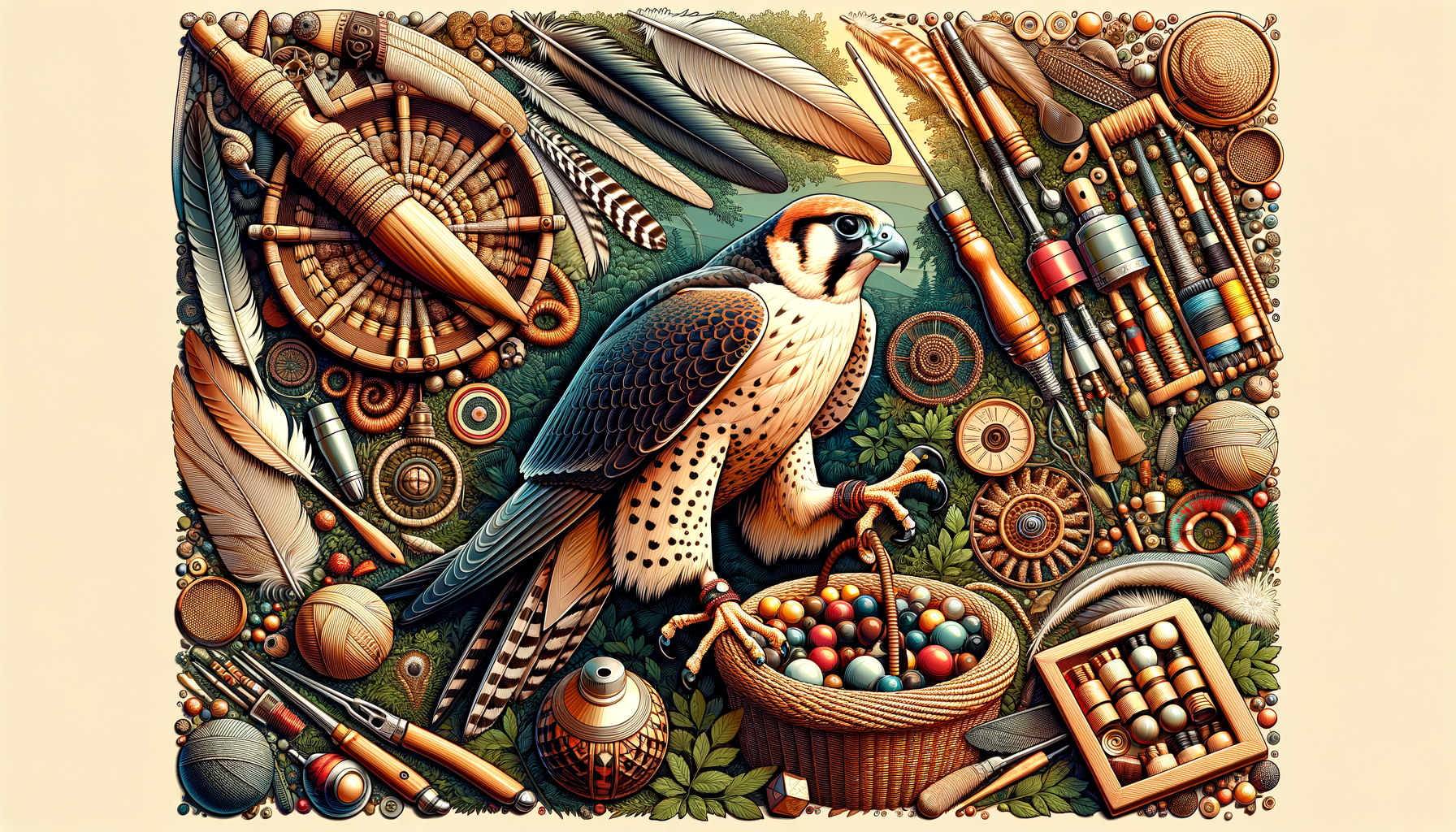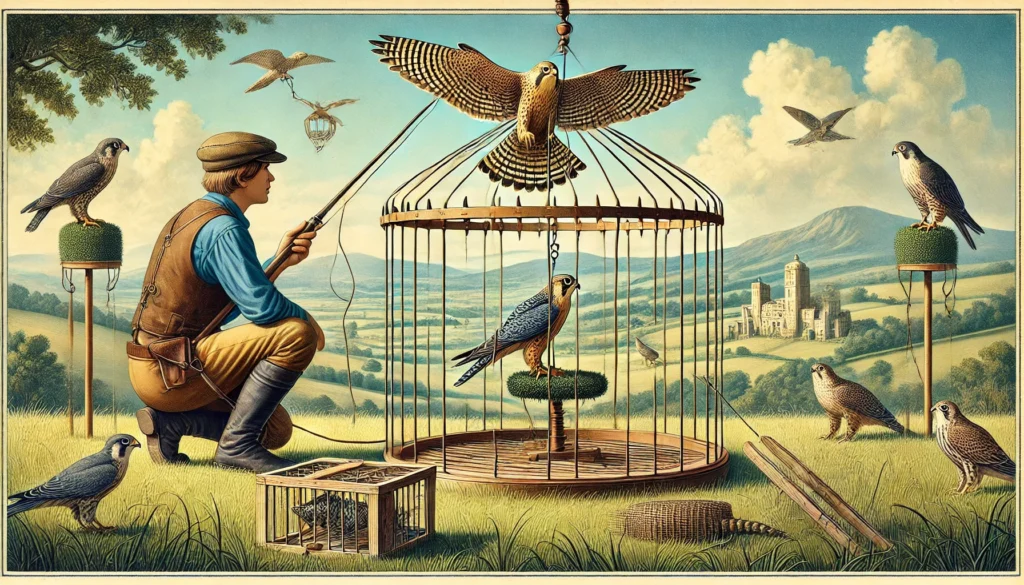Key Insights on Falconry Lures
- Falconry lures are essential tools used to train and exercise falcons.
- Different styles of lures can be used based on the falcon’s training level and method.
- Swinging lures help smaller birds practice aerial maneuvers and strengthen their muscles.
- Dangling lures encourage falcons to chase and catch moving targets, improving their hunting skills.
- The materials of the lures can include leather, wings from birds, or other durable substances.
- Proper maintenance of the lures is important to ensure they remain effective and safe for the birds.
- Observation and adaptation of your training methods, based on the bird’s response, can lead to more successful and rewarding falconry practice.
- Safety for both the bird and the handler should always be prioritized during training sessions.
Remember, using the right lure can make all the difference in improving both the falcon’s skills and the falconer’s training experience!
Unleashing the Magic of Falconry Lures: An Irish Tale
Imagine for a moment, you’re wandering through the lush, green fields of Ireland, where every hill seems to hold a secret. You’re in the company of a wise old falconer who carries a magical whistle. With just a gentle blow, a magnificent falcon swoops down from the sky, gracefully responding to the call. This magical whistle is much like a falconry lure’a tool that’s not just fascinating but essential for every falconer.
At Learn Falconry, we’re passionate about connecting humans and birds of prey in the most enchanting and ethical way. Our article on falconry lures will take you through the mesmerizing world of these tools, explaining why they are as pivotal to falconry as that Irish whistle is to calling a falcon. Just as the whistle guides the falcon, lures play a crucial role in training and maintaining the skills of these majestic birds.
By diving into our article, you’ll uncover the secrets and techniques that make falconry lures indispensable. Whether you’re a seasoned falconer or just starting, understanding the nuances of lures can elevate your experience, enhancing both the joy and the bond you share with your bird. So, as you walk through the emerald fields of knowledge, let us guide you with stories, tips, and wonders waiting to be discovered.
Keep reading, and let’s unlock the magic together!
Understanding Falconry Lures: An Essential Guide
Falconry, dating back to ancient times, uses falconry-lures in training falcons and other birds of prey. Falconry lures are crucial tools in the training and conditioning of these majestic creatures, ensuring they develop the skills needed for successful hunts and competitions.
What are Falconry Lures?
Falconry lures are designed to mimic the appearance and movement of prey animals. These tools are meticulously crafted to attract and engage the birds during training sessions. By resembling the prey falcons would naturally hunt, these lures are effective in teaching birds the skills required in actual hunting scenarios.
For more historical insights on falconry, visit our page on the history of falconry.
The Importance of Training Lures
Training lures play a vital role in the process of conditioning and training falcons. These lures can be simple or elaborate, depending on the specific training needs. For beginners, a basic lure can help establish initial training routines, while advanced falconers might use more sophisticated lures that challenge the bird’s speed, agility, and hunting techniques.
Discover more about basic training techniques for falcons and how to get started.
Types of Falconry Bait
Falconry bait usually consists of meaty treats that reward the bird once it successfully catches the lure. This reward system is essential for positive reinforcement, which encourages the falcon to repeat the desired behaviors. The bait must be nutritious and appealing to maintain the bird’s health and motivation.
Learn more about falcon health and proper nutrition on our falcon health and nutrition page.
Choosing the Right Lure for Your Falcon
Selecting the appropriate lure depends on several factors, including the species of falcon, the training goals, and the bird’s current skill level. Each type of falcon, from the fast-flying Peregrine Falcons to the powerful Gyrfalcons, benefits from specific types of lures designed to meet their natural hunting styles.
Visit our comprehensive guide on different species of falcons to understand the unique needs of each bird.
Crafting and Maintaining Falconry Lures
A well-crafted lure is crucial for effective training. While many falconers purchase ready-made lures, others prefer to make their own, tailoring them to specific training requirements. Maintaining these lures by regularly inspecting and repairing them ensures longevity and efficiency in training sessions.
For tips on maintaining your falconry equipment, explore our resources on necessary falconry equipment.
Incorporating Lures into Training Techniques
Falconry-lures aren’t just tools’they’re integral to a falconer’s training techniques. Techniques such as lure flying help in honing the bird’s hunting skills, simulating real-life hunting situations. By repeatedly practicing with lures, falcons become adept at recognizing and capturing prey.
Read more about advanced lure flying techniques to elevate your training sessions.
Understanding and utilizing falconry lures effectively can significantly improve the training and performance of your bird of prey. Whether you’re new to falconry or an experienced falconer, the right tools and techniques make all the difference in creating a strong, skilled, and healthy hunting partner.
Understanding Falconry Lures in 2024
Falconry lures play a crucial role in training birds of prey such as falcons, hawks, and eagles. These tools are designed to attract and simulate the movement of natural prey, thereby helping falconers train their birds for hunting and increasing their agility and responsiveness. Let’s dive into the specifics of falconry lures to understand their complexities.
Materials Used in Falconry Lures
The primary material employed in making falconry lures is high-quality leather, typically cowhide. This makes the lure durable and capable of withstanding the repeated assaults of a raptor’s talons. Here are some common materials used:
| Material | Description |
|---|---|
| Cowhide | Durable and long-lasting, withstands attacks and maintains its shape |
| Synthetic | Lightweight options that mimic prey movements more realistically |
| Feathers | Added to enhance the visual appeal and realism of the lure |
Types of Falconry Lures
Various types of lures are available to mimic different kinds of prey animals, aiming to match the natural hunting behaviors of the bird being trained. Some common lure designs include:
| Type of Lure | Mimics | Best For |
|---|---|---|
| Rabbit Lure | Rabbits | Falcons, hawks |
| Bird Lure | Small game birds like quail | Hawks, eagles |
| Fish Lure | Small fish | Eagles, ospreys |
Design of Falconry Lures
Lures are meticulously designed for both functionality and durability. They are compact with realistic profiles that appeal to the predatory instincts of birds of prey. Key design characteristics include:
- Compact Shape: Making it easy to carry and deploy.
- Realistic Appearance: Enhances likeness to actual prey.
- Durable Construction: Reinforced joints make them last longer.
Here is a common example of a lure design:
| Feature | Purpose |
|---|---|
| Realistic Paint | Mimics the appearance of prey and attracts the bird |
| Weighted Tail | Adds balance and ensures the lure moves in a natural manner |
| Feather Additions | Increases the realism and visibility of the lure |
Durability of Falconry Lures
One of the foremost aspects of a falconry lure is its durability, designed to endure the intense training sessions. These lures often include:
- Reinforced Joints: To handle the stress of impacts.
- Durable Materials: Hi-tech plastics, acrylics, and polymers that offer resilient flexibility.
Variety of Falconry Lures
Lures vary in size and style to cater to different bird species and hunting techniques. Here’s a brief look at the typical size trends:
| Bird Type | Common Lure Sizes |
|---|---|
| Falcons | Small (2 to 3 inches) |
| Hawks | Medium (3 to 5 inches) |
| Eagles | Large (5 to 8 inches) |
Understanding these facets of falconry lures helps both novice and experienced falconers make informed decisions on selecting the right equipment for training their raptors effectively.
The Art of Falconry Lures: Final Thoughts
We’ve taken a closer look into the fascinating world of falconry lures, specially crafted to appeal to these magnificent birds of prey. Here are the most important points to remember:
-
Materials and Durability: Falconry lures are crafted from high-quality materials like leather, ensuring they stand the test of time and can handle the wear and tear of training and hunting.
-
Types and Designs: There are various types of lures, each mimicking different prey animals, such as rabbits or birds. The designs are compact with lifelike profiles, making them especially attractive to falcons, hawks, and eagles.
-
Versatility and Innovation: From small and intricate lures to larger glide baits, the variety caters to different bird species and hunting techniques. Features like internal weighting systems and articulated bodies add to the lure’s effectiveness.
-
Regulatory Awareness: Falconers must be aware of regional regulations, including the types of quarry species allowed and reporting requirements for any accidental takes.
Falconry lures are essential tools that enhance training effectiveness and hunting success. By understanding their materials, types, and how to use them responsibly, you can sharpen your skills and enjoy a more rewarding falconry experience. Leverage these insights to become a more skilled and knowledgeable falconer, always respecting the majestic nature of the birds and the art itself.



